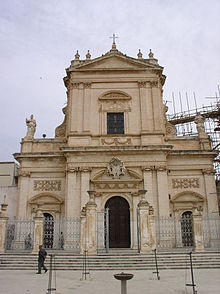Ispica (Sicilian: Spaccafurnu, Latin: Hyspicae Fundus) is a city and comune in the south of Sicily, Italy. It is 30 kilometres (19 mi) from Ragusa, 50 kilometres (31 mi) from Syracuse, and 90 kilometres (56 mi) away from La Valletta, on the coast of Malta. The first mention in a document of Ispica occurred in 1093, in a list of churches and ecclesiastic departments for administrative purposes, but the territory has been colonized since the Bronze Age.
The city is located on a hill. The main economical activity consists of farming and organic products, especially carrot, zucchini, tomatoes, olives, vineyards. Ispica is the largest producer of organic carrot of southern Italy with about 18,000 tons of annual production. There is 10 kilometres (6 mi) of coastline, most of which is sand and dunes, and an island (Porri island) at 2 kilometres (1.2 mi) from the coast.
The town also hosts examples of Sicilian Baroque architecture such as the Vincenzo Sinatra's Basilica di Santa Maria Maggiore, the Annunziata Church, the Carmine monastery, and the St. Barthelemy cathedral.
Ispica was destroyed by the 1693 Sicily earthquake and rebuilt on its present site.
Tourist Information

The Pro Loco Spaccaforno manages a tourist information point in the city center. Tourist information, also in English, is available on the website Visit Ispica.[3] There are a number of processions which take place on Holy Thursday.[4][circular reference] If traveling to Ispica, the bus station is in a much safer and more convenient location than the train station, which is located on the outskirts of town.
The Cava d'Ispica (Cave of Ispica) consists of a series of housing units.
Cava d'Ispica
The Cava d'Ispica (Cave of Ispica) consists of a series of housing units carved in rocky formations. Built prior to the Greek colonization, these houses were used until the end of the nineteenth century. This cave, the most important in Eastern Sicily, is 13 kilometres (8 mi) long and is divided among two other comunes, Modica and Rosolini.
People
- Corrado Lorefice, (1962) archbishop of Palermo
References
- ^ "Superficie di Comuni Province e Regioni italiane al 9 ottobre 2011". Italian National Institute of Statistics. Retrieved 16 March 2019.
- ^ "Popolazione Residente al 1° Gennaio 2018". Italian National Institute of Statistics. Retrieved 16 March 2019.
- ^ Visit Ispica - things to do and events in Ispica
- ^ Archconfraternity of Santa Maria Maggiore of Ispica (in Italian)
Sources
- Trigilia, Melchiorre (1989). Storia e guida di Ispica. So.Ge.Me Editore.
- Visitispica.com Visit Ispica - English Website Visit Ispica is a registered trade mark by Pro Loco Spaccaforno



Recent Comments